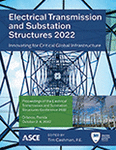Electrical Transmission and Substation Structures 2022
Influence of Steel Pole and Davit Arm’s Deflection on Clearance to Structure Calculations
Publication: Electrical Transmission and Substation Structures 2022: Innovating for Critical Global Infrastructure
ABSTRACT
Tubular steel poles with davit arms are used extensively as high-voltage transmission line support structures—a double-circuit tubular steel pole with davit arms and I-string insulators is one of the quintessential tangent pole configurations. A davit arm’s length in a suspension application is often dictated by the combination of the I-string insulator’s swing and the required clearance from energized conductor or hardware to the structure under the conditions that produced the swing. To maximize design efficiency of a transmission line, the line designer should be aware of all factors that influence system performance. The pole shaft and arm deflections are factors often overlooked for clearance to structure calculations. National Electrical Safety Code (NESC) Rule 235E states that a flexible structure’s deflection shall be considered in clearance calculations to the supporting structure. Since most davit arms are not designed considering arm deflection limits, arm deflection could result in significant variability in the actual clearance values. With limited design information available during the early phases of a project, most transmission line designers must make reasonable allowances over required clearance values to accommodate the anticipated pole shaft and arm deflection’s impact. This paper will study how the additional clearance allowances established during the initial phases of design to accommodate pole shaft and arm deflection compare to the final installed condition. The study will include analysis of typical configurations of double-circuit tubular steel poles with davit arms and I-string insulators. This study will also examine some of the controls that could be established during various phases of the design process, such as using a deflected structure shape for allowable insulator swing calculations, limiting arm deflection, and communicating an arm rise value to counteract the arm deflection. These controls, among others, may limit the variability between the allowable swing angles established during the early phases of the design and the actual clearance to structure observed.
Get full access to this article
View all available purchase options and get full access to this chapter.
REFERENCES
Accredited Standards Committee C2-2017, National Electrical Safety Code® (NESC®).
U.S. Department of Agriculture, Rural Utilities Service, Electric Staff Division. “Bulletin 1724E-200 Design Manual for High Voltage Transmission lines
Information & Authors
Information
Published In
Electrical Transmission and Substation Structures 2022: Innovating for Critical Global Infrastructure
Pages: 358 - 365
Editor: Tim Cashman
ISBN (Online): 978-0-7844-8446-3
Copyright
© 2022 American Society of Civil Engineers.
History
Published online: Sep 20, 2022
Published in print: Sep 20, 2022
Authors
Metrics & Citations
Metrics
Citations
Download citation
If you have the appropriate software installed, you can download article citation data to the citation manager of your choice. Simply select your manager software from the list below and click Download.
